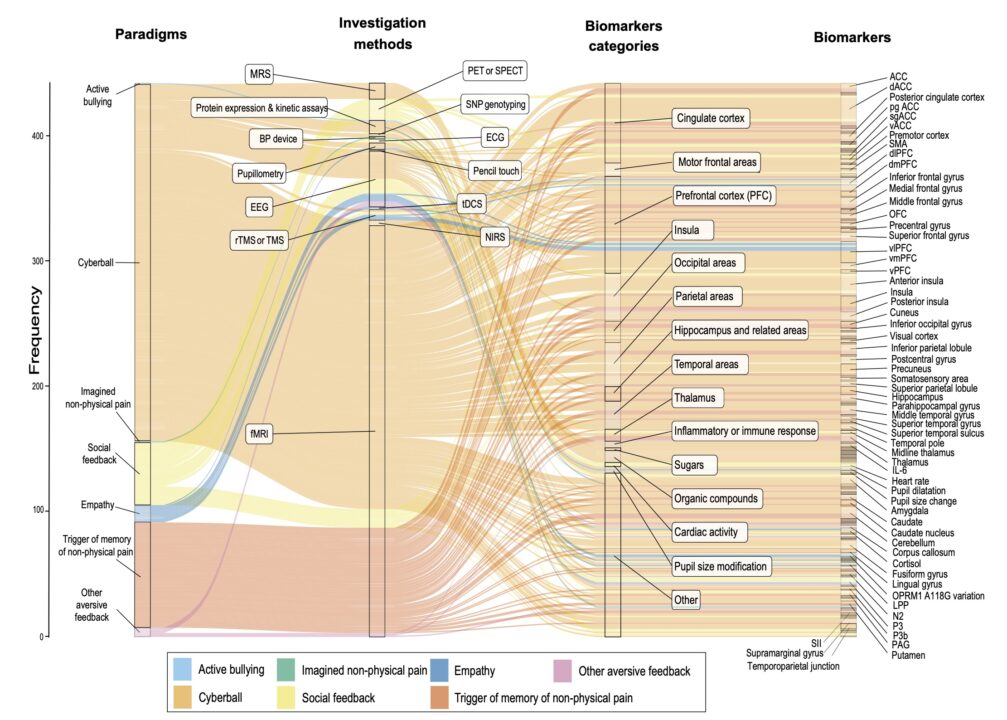Studies on non-physical pain used heterogeneous concepts and methods, with unclear external validity
Multiple teams of researchers in neuroscience and experimental sciences seek to elucidate the biological foundations of non-physical pain, defined as a painful experience not primarily felt in the body. An example of non-physical pain is mental pain, which has been identified as an important domain to consider in the treatment of depression by persons with lived experience and healthcare professionals. The presence of mental pain, in the context of depression or another psychiatric disorder, is also considered a risk factor for suicidal behavior.
Understanding the biological mechanisms underlying all types of non-physical pain, such as mental pain, could enable the development of biological treatments targeting these mechanisms. Such treatments would be potentially more effective in alleviating the suffering of individuals experiencing these conditions. There was no existing research mapping on the biological mechanisms of non-physical pain. Such research mappings involve the identification and critical synthesis of the various concepts, methods, and populations studied within a given scientific field. They assist researchers in a field to understand what studies have already been conducted, what scientific questions remain unanswered, and what are the limitations and advantages of the exploration methods used in a field of research.
Researchers from the METHODS team conducted the first research mapping on the biological mechanisms of non-physical pain. They systematically examined all studies investigating the biological mechanisms of non-physical pains. This study was supervised by Dr Astrid Chevance as part of a Master 2 in Public Health at the METHODS team by student Étienne Duranté, first author of the publication. E. Duranté and his colleagues analyzed 92 studies on the biological mechanisms of non-physical pain, involving nearly 8,000 individuals. For each study, the researchers analyzed the terms, definitions, induction methods, and measurement methods of non-physical pain.
The researchers found that most studies did not clearly define what “non-physical pain” was and used rather varied terms to describe it. They used numerous and different measurement tools, developed for very different concepts of non-physical pain, such as social anxiety or the frustration of basic needs. The majority of studies exclusively included participants without documented psychiatric disorders, while the methods used to induce or simulate non-physical pain in laboratory settings appeared very different from the experiences of non-physical pain actually experienced by individuals with mental health conditions. Finally, many studies did not measure important factors that could influence the results obtained and the conclusions drawn for clinical practice. All of these elements contribute to an inability to compare and aggregate the results of these studies for the development of new therapeutics.
To improve the quality of future research on the biological mechanisms of non-physical pain, the researchers from the METHODS team recommend agreeing on a clear definition of non-physical pain, developing a suitable and relevant tool for its measurement, and developing induction methods that better mimic real-world situations, as is done for physical pain.
- Duranté, E. K., Ribeiro, A., Gaspard-Boulinc, L., Boutron, I., Henry, C., Petit, A.-C., Houenou, J., Lemogne, C., Chevance, A. (2025). Biological research on mental pain, social pain and other pains not primarily felt in the body: methodological systematic review. The British Journal of Psychiatry, 1–11. doi:10.1192/bjp.2024.292
Read the article
Par Etienne Duranté
etienne.durante@inserm.fr
